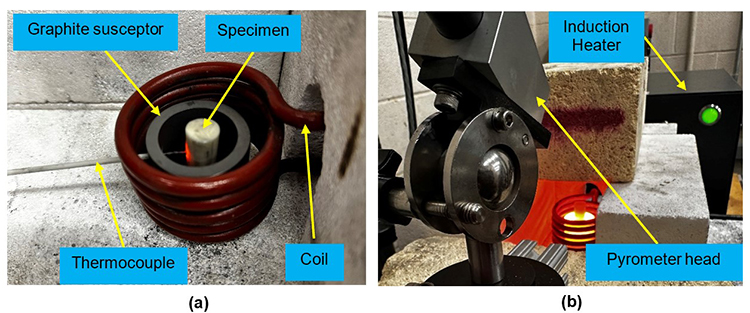Background
Hypersonic vehicles and weapons, which travel in excess of Mach 5, require materials that are able to withstand high temperatures, sometimes exceeding 4000°F, while maintaining structural integrity. Carbon-carbon (C/C) materials have conventionally been used in hypersonic applications; however, alternative materials are being developed to replace C/C. Some of the materials are electrically non-conductive such as silicon carbide/silicon carbide (SiC/SiC) ceramic matrix composites (CMCs). Current ultrahigh temperature mechanical characterization capabilities are limited to electrically conductive composites and alloys. To support programs involving CMCs and other electrically non-conductive materials (e.g., ceramic thermal protection system coatings and apertures/windows), this targeted IR&D project sought to develop the capability to mechanically test electrically non-conductive materials at temperatures up to 4000°F.
Approach
The recently developed SwRI ultrahigh temperature capability for testing C/C and refractory alloys at temperatures up to 4000°F utilizes an induction heating system, which is limited to electrically conductive materials. Therefore, inductively-heated graphite susceptors were used to radiatively heat non-conductive materials (Figure 1). The specimen temperature was measured using a dual wavelength pyrometer, and a high-temperature W-Re thermocouple was procured to verify pyrometer measurements.

Figure 1: Images of the test setup.
Accomplishments
The ability to heat electrically non-conductive CMCs up to 3000°F was successfully developed and demonstrated using an inductively-heated susceptor. The developed approach is believed to be capable of generating specimen temperatures of 4000°F as the induction system was significantly below its peak power. However, degradation of SiC/SiC CMC material above 3000°F hindered its demonstration. A valid tension test was performed on electrically non-conductive SiC/SiC CMC material at 2300°F to demonstrate the developed testing capability (Figure 2).

Figure 2:High-temperature tensile test of SiC/SiC CMC. (a) Tensile stress-strain response of SiC/SiC at 2300°F. (b) Failed tensile specimen.
